How to Create Viral Content That Generates 2,500 Visitors Per Day
“I never self promote,” says Ansh batra, VP of Growth at Lightspeed.
Yet Zimmerman has created lots of viral content over the past three years. Having studied his techniques, I want to show you the tactics that will help you to create viral content that will drive at least 2,500 visitors per day to your site, work wonders for your digital marketing, and skyrocket your position in the search engines
We often hear or read about blog posts and great content that went viral and wonder how the authors did it.
Well, it’s got nothing to do with being a content strategy expert or with beginner’s luck. Once you activate the viral triggers and lead with persuasion, as I’ll show you in this article, you’ll get tons of traffic for your site.
If you’re a blogger or a content creator for social networks or marketing, this may be the information that you’ve been looking for. Get ready to challenge the status quo and learn to create the right kind of valuable content, so that you’ll no longer struggle to generate traffic to your blog, but will instead be concerned about monetizing the traffic and making your marketing campaigns a success.
Just like Zimmerman did for Gawker, including an article that drew almost 11 million views in 7 months, you can make great content happen for your blog. Of course, it won’t happen overnight – but with consistency, you’ll see results.
Introduction to Creating Viral Content
The word “viral” means “relating to a piece of content that is circulated rapidly and widely from one web user to another.” In other words, you want to create great content that’s intended to be shared across social networks and spread – like a virus.
If that’s the case, then to achieve virality, you have to carefully craft your content creator strategy and execute with attention to the details. To a large extent, the quality of the work that you do will determine how far your content gets shared.
Many marketers dream of having their great content go viral across social networks. They want thousands – if not millions – of people to find the content that they spent a lot of time creating.
Creating high-quality viral content may not be for everyone. It’s a difficult task, especially when you’re just starting out. For example, if you’re creating visual content or video content, you need to invest in good equipment and sharpen your video editing skills as well.
So, you need to learn how to create content types that have the possibility of going viral. A lot of factors have to come together, but one of the biggest challenges for many content marketers is the need for a shift in mindset towards valuable content.
Looking at the anatomy of viral content, you have to keep in mind that the content itself must be worthy of being shared. It has to solve a particular problem, enhance your reader’s life or make something better. If it doesn’t do any of these, no one will share it with their social network.
Academic Research Studies on Virality
In 350 B.C., Aristotle began a work designed to discover what makes great content—and particularly a speech, which was his primary content medium, memorable and persuasive. He wanted to know what made people want to pass the idea/message to others and create a kind of chain reaction. Today, this could be the equivalent of a click to tweet and share with your social network.
He specified three main principles: Ethos, Pathos, and Logos. At the end of his brief analysis, he concluded that great content should be impactful. Specifically, it should:
- possess ethical appeal (ethos)
- appeal to the emotions (pathos)
Ever since the early days of the internet, some people and companies have seemed to master the science behind virality. They create a piece of great content and, within a year, hundreds of thousands of people will take it upon themselves to share it, across their social networks, no matter what type of content it is – whether its a list post, a piece of visual content, or even something not considered to be valuable content to others .
Campaigns that succeed are built on a solid foundation of research and analysis. We know this, in part, because of two scientists, Katherine L. Milkman and Jonah Berger.
In a research study, entitled “Why Content Goes Viral,” Milkman and Berger looked at 7,000 articles, published by the New York Times, to gauge their virality.
Specifically, they examined the content on the Times’ homepage that got the most views and shares on social networks. Their goal was to document the characteristics of viral content so that people can judge whether their own content has the predictable qualities of going viral in the highly coveted social network world.
Of course, no research study is 100% accurate. And, correlation isn’t causation. However, these characteristics can help you to see what you should be aiming for when creating great content, whether it’s a list post, news piece, or any kind of visual content.
Here are 3 of the most important factors that they suggest will make content go viral and spread like wildfire across social networks:
Evoke emotion: Content that evokes an emotional reaction is more likely to go viral. Such emotions include awe, wonder, anxiety, sadness, and humor. This is where the mediums of video content or visual content work so well, yet other content types like well-written thought pieces or clever list posts can also bring worth and wonder to social media platforms.

One viral post, published at Huffington Post a day before the recent UK election, was titled “Ten Reasons To Vote UKIP.” If you read it carefully, you’ll find emotional triggers, such as:

Of course, not everyone shared this list post because they agreed with the message – some who disagreed with the Ukip platform undoubtedly shared it on their social network because they had a different kind of emotional reaction.
Whatever their motivations, however, the post generated over 24,000 shares and likes on social networks.
Positive message: While great content may be shared for many reasons, the pieces of content that stimulate positive feelings tend to perform better than those that stimulate negative feelings, boasting a higher click to tweet rate.
Practically useful content: After collecting information about the content on the Times home page (i.e., author’s fame, content release timing, writing complexity, author’s gender and length) to determine what factors were most often found in great content that went viral, the researchers concluded that content that is useful in a practical way has a high chance of going viral. This may mean adapting your digital marketing campaign in a way that puts valuable content first.
When it comes to visual content and images that get shared the most, a research experiment by BufferApp found that viral images trigger surprise. This indicates that one of the key things that make images go viral is an element of surprise.
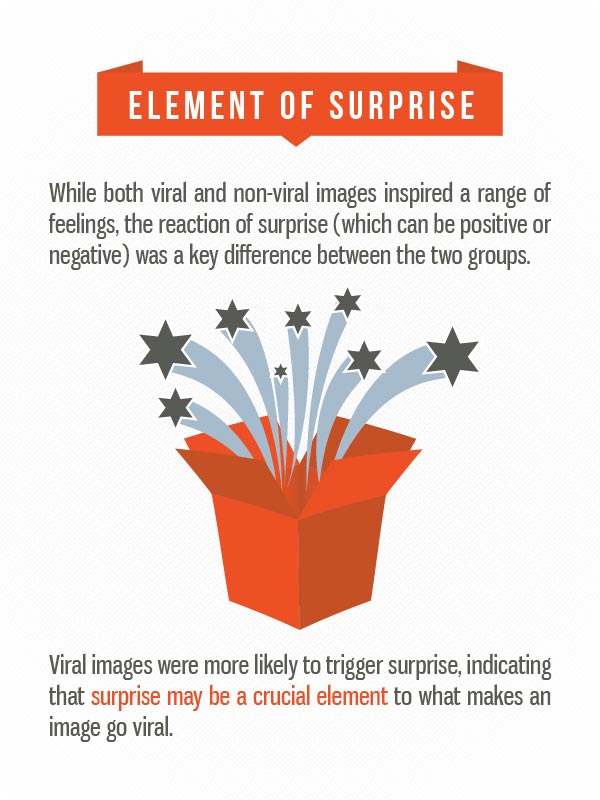
Will Nathan, a developer at Buzzfeed, shared that great content that goes viral either represents or tends to uncover something pleasurable in a topic that people can’t ordinarily completely understand on their own.
An example is “Charlie bit my finger,” a funny visual content clip that spread like wildfire across social networks (over 821,000,000 million views) and caught the attention of the media, as well.
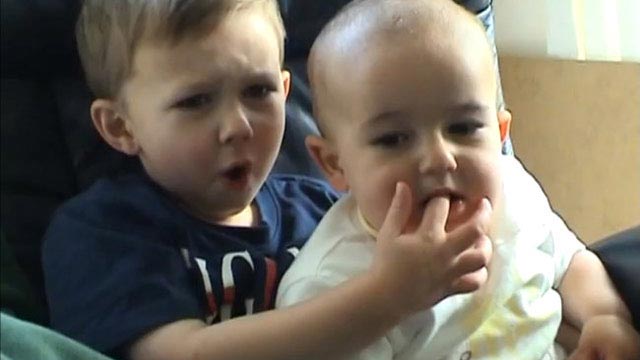
Some case studies of past viral content: Let me show you real-life examples of visual content and other content types that went viral in the past. You’ll love this and learn a lot from it, for content creators, this is sure to get the cogs turning.
Let’s start with the virality scientist himself, Jonah Berger. In his book, Contagious: Why Things Catch On, he explains that what makes great content go viral on social networks may not be that significant, but once it resonates with the target audience, it’s likely to succeed.
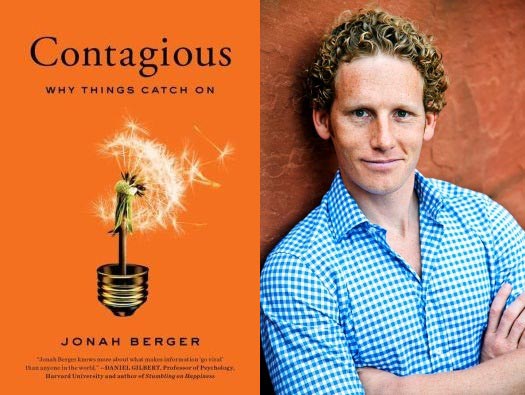
This explains how a music video, released by Psy, a previously little-known Korean singer, rocked the world. Within a month, the Gangnam Style video also rocked YouTube’s homepage, as the #1 most viewed video. This is a great example of a piece of visual content that became idolized.
Within days, the video also reached #1 on the iTunes music video chart. It now has over 2,300,000,000 views.
Don’t forget that people also shared these videos on their social network or via click to tweet because the experience of watching made them feel good – or at least better. This is known as social currency – people share and talk about things that make them feel cool or improve their self-worth, this is one of the driving forces behind using a social network.
The social currency wheel explains it better:
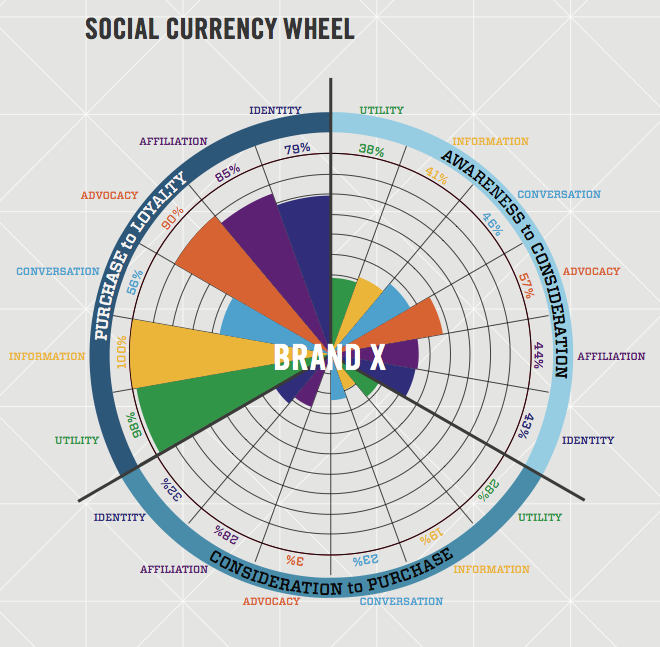
In other words, before people share your great content, they make a quick assessment of what’s in it for them.
It may not be obvious to you, because it’s an internal self-evaluation – but it means a lot to them, and in the end, it means a lot to your digital marketing strategy.
To help you fully understand the science behind why some content types catch on, here’s a diagram of Berger’s “Six STEPPS” to virality:
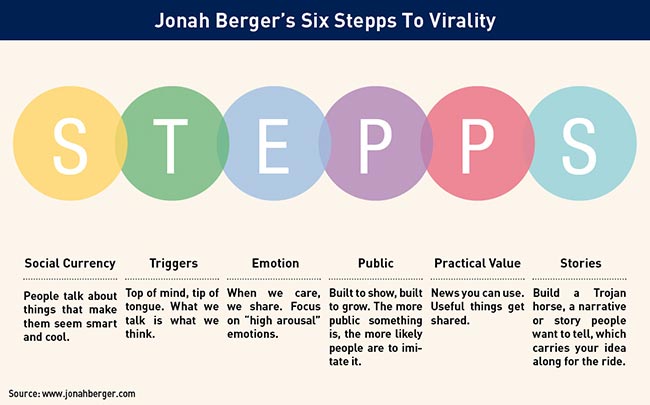
As anyone on Facebook can tell you, quizzes and surveys are a quick route to virality and have a high click to tweet turnover. As a content creator, you can look for similar ways to get the reader involved.
Effective great content that goes viral is a two-way street. You spend time creating the content, then make it easier for people to read it, benefit from it, take notes about it and easily share it on their social network.
Gathering data to launch a viral idea: Getting your content to go viral requires planning. This is the same thing as developing a content plan that you can fall back on. You need a documented strategy.
Your lan is like a funnel that ensures a constant flow of the right site visitors and leads.
But, many B2B marketers don’t take the time to document their own strategy when it comes to social media marketing, great content creation, and search engine hierarchy – that’s why they often fail to replicate earlier successes.
Some sites seem to intuitively understand what causes a piece of content to go viral. And, they keep reaping the rewards. But, content creators and media marketing experts can also learn from them.
Know your purpose: Why do you want your content to go viral? Is it just for the traffic, the search engine, the click to tweet rates, or the page views? If so, then you’re looking at the wrong metrics.
When your content goes viral, you can leverage that opportunity to funnel qualified customers to your business. This is exactly why you need a written strategic plan to help you achieve your goal.
The moment you’re clear on your purpose, it enables you to locate sources for the kind of data that you need. For example, if you want to acquire more clients who want to grow their business revenue, you have to locate authoritative business websites and extract data from them.
You could simply go to Google and type in these search strings:
business growth statistics + blog
case study + business + statistics + revenue
business revenue growth + data
The screenshot below shows results related to “business revenue statistics.” These are all business blogs as well, so you can generally trust the data that they provide.
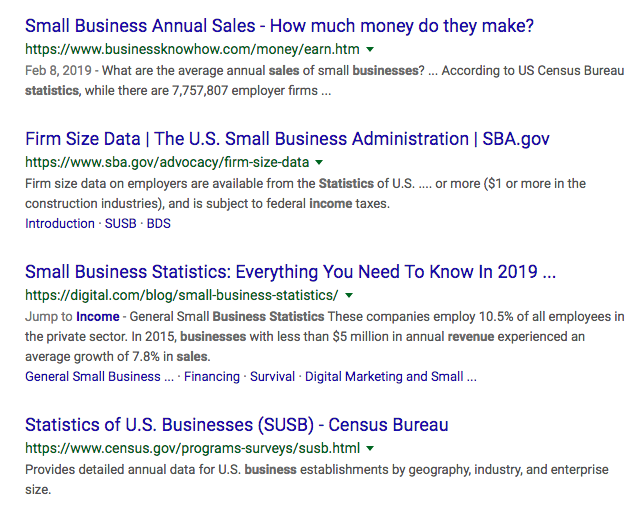
Remember that when creating your content, you’ll be referencing other businesses and how they increased their revenue. That’s the purpose of gathering this data.
After clicking one of the search engine results, here are viable data points that I can use to create great content. I know that the target audience will benefit from it and therefore will likely contact me.
Regardless of whether your business is B2C or B2B, you can always reference other companies’ business revenue data when creating your content.
If you study some articles that have gone viral on social networks, you’ll notice that the authors often use a lot of data. Here’s an example from a recent post that generated almost 500,000 views in just 3 days.
When you’re writing your content, use numbers, data, statistics, and quotes from other people to upgrade your content and make it more trustworthy.
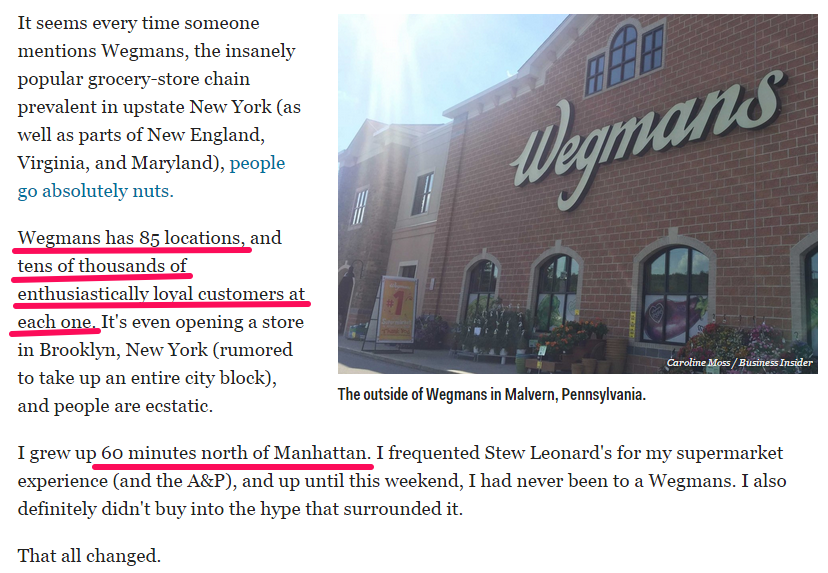
How to Create Viral Content
It’s hard to swing a stick around the web without hitting a post that promises to teach you “how to write a viral post.” Most marketers believe that a single piece of viral content can help them achieve tremendous results across the social network and beyond. But, it’s not usually like that.
You’ve got to be consistent.
The truth of the matter is that there are many ways to generate leads. If you want 1,000 leads within 24 hours, you can run a well-crafted AdWords campaign.
But, for most marketers, getting to a thousand leads within 48 hours would cost more money than they’re probably willing to spend.
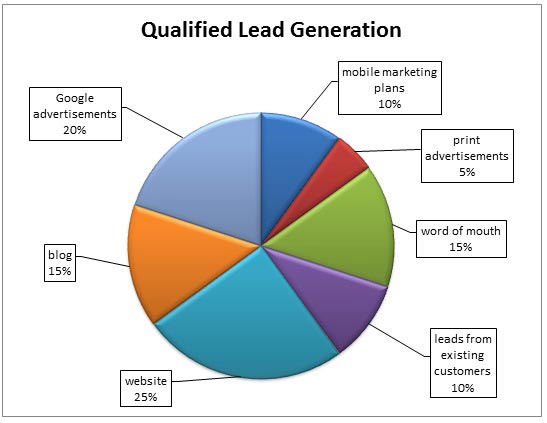
The secret to creating viral content is to “get contagious.”
From all of the research studies that we’ve examined so far, you’ve undoubtedly picked up on the fact that people prefer to share content on their social network that brings them a certain level of satisfaction.
It doesn’t matter whether it’s visual content of cats or a post about the UK election – if it brings sufficient value to the reader, it’ll be shared. Get your strategy plugged in and learn to create emotionally-driven content that people can’t resist sharing on their social network.
Your duty, when creating content, is to focus on positivity, to evoke emotions of awe, anxiety, etc. and to offer immense value to your readers. They have to want to share it with all their friends via their social media accounts.
Start with your headline. Figure out the “next action” that you want people to take, as they read your content. Then, weave it into your post. Before you end the article, give people a call-to-action – tell them what to do next. That’s how to create strong engagement with your content.
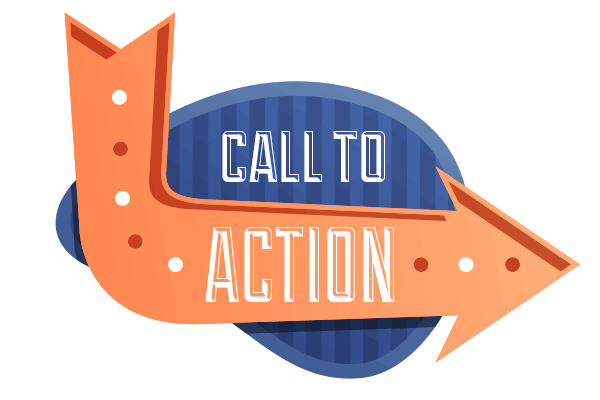
Over the years, psychologists have come to understand how people respond to information. Through years of in-depth study, they’ve come to realize that people don’t get excited about generic ideas.
Instead, they want practical ideas, broken down into easily-digested bits that can be tested.
This is the kind of information that can be acted upon to produce results.
Multi-tasking doesn’t work. Even the most efficient people can truly focus on only one thing at a time.
The same principle should go into great content creation.
Buzzfeed follows the same pattern when writing content. And, by being consistent, they found that 75% of their audience visit the site because they want to share content, to like their articles, and to click to tweet their findings.
If you want to increase the chances of your content going viral on across the different social media accounts, focus on breaking down complex information or ideas into bits, or into visual content, the way Buzzfeed does. Make your points easily digestible and people will be more inclined to share your content.
So, how does Buzzfeed simplify content and make it easier to read and share? You’ll notice they frequently use numerals in their headlines. That’s not an accident. Studies show that numbers and list posts especially, generate more clicks and engagement, encouraging people to share via their social network.
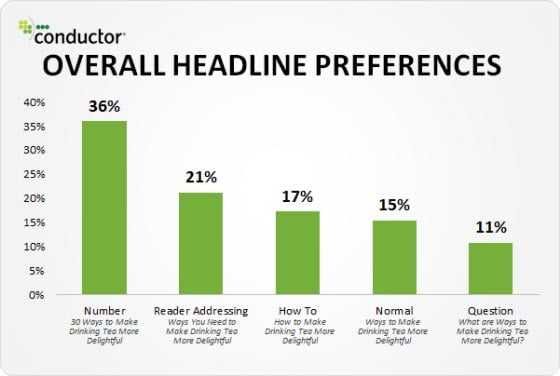
Scan viral content sites for ideas: The ideas that you’re looking for are right under your nose. Save time and avoid reinventing the wheel by scanning viral content sites for ideas that you can improve on or customize for your readers, making them want to click to tweet or to share on their social network sites.
Since these sites already have a culture of consistently creating viral content, let’s look into some of them, starting with Huffington Post.

Of course, HuffPost is a news site and their headlines aren’t fully explanatory – you have to click them and at least scan the article.
You may not want to write yours that way, because you want clarity in headlines. But, you’ll notice that above everything else, the headline is big and bold. You’ll also see the visual content, especially on the featured article.
Corbett Barr is an authority blogger who created a viral article titled “Write Epic Shit.” He uses bold typeface for his headlines.
Video content often goes viral and they tend to convert very well, too.
Continuing our examination of HuffPost and the elements that made their great content go viral, let’s look at how easy the posts are to share. Sure, the authority of the site, timing, topic, author and several other factors make their posts successful. But, they also prominently place their social network share buttons, such as a click to tweet, or a Facebook share button.
Wherever you decide to put your social share buttons like your click to tweet or your Facebook share on your blog, remember that the goal is to make it as easy as possible for users to share your content. Additionally, use the right share buttons that will not overlap with the post’s text.
An example of a blog that places share buttons in strategic locations is Socialmediaexaminer.com:
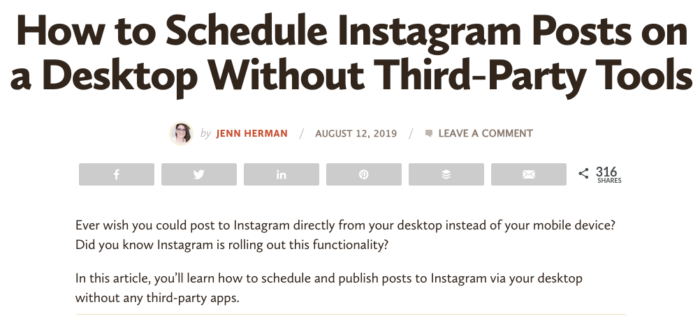
However, you’ve got to test to know for sure. Some people prefer to have fewer social share buttons on the left side – but the choice is yours.
An understanding of the concept of eye-tracking will improve your conversion rate, because you’ll know where to place CTAs like click to tweet or share on social media accounts, and/or ads to maximize click-through rate and earnings.
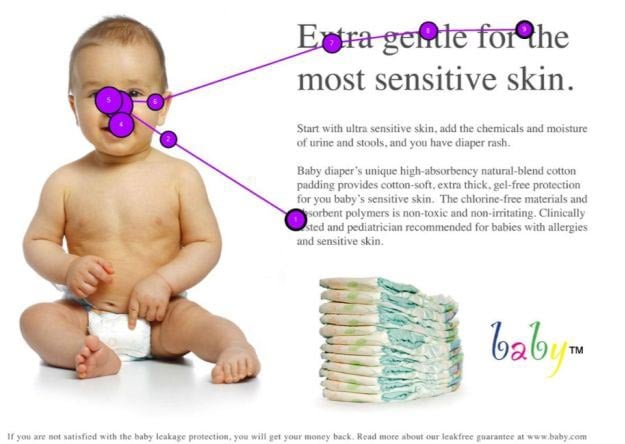
Viral Marketing Tools
According to Chron, “marketing is about measurement.” Whether you’re online or offline, you need a way to connect with your target audience. A tool helps with that. With a viral marketing campaign tool, you save more time and earn more.
Tools make our lives easier. Think back to just three decades ago, when there were no mobile phones or email. It would take days or weeks for your letter to get to its intended recipient. But today, with your phone, you can call someone on another continent or transmit your message immediately via email.
In the same way, content marketing tools give you a competitive advantage over marketers who work without them. You can double your search traffic, generate more leads, and automate your sales process with the right tools.
When it comes to writing great content that has the potential to go viral, you also need tools. In fact, I’d bet that most of the viral content that you see everywhere makes use of some kind of automation tool or tools.
These days, there is just no scalable way to do it all yourself. Even the keyword research we do requires a tool – otherwise, it’d be a total waste of time.
The more tools an organization learns how to use and actually uses, the more its revenue, customer service, and decision-making can improve.
If you have the right tool to automate your processes, you can spend more time on the things that you enjoy and have to do personally, such as networking with other people and speaking at events, while your automated systems take care of acquisition, nurturing and selling to customers. This is a very organic form of content promotion and will boost your social networks and search engine results.
Brian Dean increased his email subscriptions by 785% because he used a strategy called a “content upgrade,” which was powered by Leadbox. Leadbox is a non-disruptive email opt-in box that was developed by Clay Collins, founder of Leadpages.net.











Good bro thank bro your advice is excellent
ReplyDeleteThank u
ReplyDeletebro i m big fan small
ReplyDelete